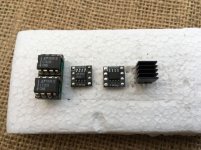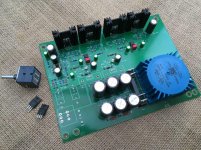What did you use for C2/C7 ?
A 75mhz opamp on a pcb clearly not designed for high speed opamps and without any rfi filter is begging to oscillate, especially if an adapter is used.
Forgot to ask Greg this, for my part, C2/C7 were left out and the LT1028's worked fine. I even added 10pF ceramics across pins 5 & 6 on both chips as suggested in the spec sheet but to be honest I didn't think it made a difference.
The LT1361 has even faster slew and settling and I think it sounds very good. Again with no compensation caps fitted, however with 100pF for C2/C7 it oscillated immediately. More experimentation is needed possibly with a scope to really see what is going on.
Generally, it seems Wayne's standard circuit is a universally forgiving design for most op-amps but clearly tweaks can be made for optimal measured performance.
100pF is heavy, I'd be wary to use it universally indeed.
The opamp I'd personally try is the opa1642: fet input, low distortion, relatively insensitive to input impedance mismatches, hardened against rfi and not ridiculously fast. What's not to like ?
Thanks, 00940 for pointing out this opamp. I will get a few OPA1642AID on my next Mouser order.
Compared to the OPA1612AID it has a tiny bit more noise and distortion and a tad slower slew rate but it will be very interesting to compare the JFET inputs in the 1642 to the bipolar inputs in the 1612.
I love the sound of the 1612 but also really like JFETs in the various Pass designs I have built.
100pF is heavy, I'd be wary to use it universally indeed.
The opamp I'd personally try is the opa1642: fet input, low distortion, relatively insensitive to input impedance mismatches, hardened against rfi and not ridiculously fast. What's not to like ?
Agreed, tried a pair of 1641's and they were very good.
Trying to learn more about op-amps and this is a good read if anyone has the time:
https://www.analog.com/media/en/training-seminars/design-handbooks/Basic-Linear-Design/Chapter1.pdf
Reading through various spec sheets, it seems different op-amps like certain operating current (Quiescent current) Am I right in thinking that R35/R36 47R sets the Quiescent current?
For instance OPA627 = 7mA / LT1028 = 8-10mA / OPA1642 = 2mA!
I remember trying the OPA627 when I purchased a bunch of op amps to try. The DC offsets were high above 20v so I didn't plug in my headphones and listen to it. I bought it again thinking I haven't purchased this one. @greg did you lower your offsets for this? If so how did you do it?
I remember trying the OPA627 when I purchased a bunch of op amps to try. The DC offsets were high above 20v so I didn't plug in my headphones and listen to it. I bought it again thinking I haven't purchased this one. @greg did you lower your offsets for this? If so how did you do it?
Your offset was higher than the rail voltage, Is that even possible? They are single channel amps, you need two on an adapter.
Sorry for late reply guys! I was messing with Microsoft Family yesterday to spy on digital life of the kids...
No I haven't measured the offset with OPA627. I will tonight!
No I do not have C2/C7. All opamps (except LT1028) work fine without these.
But to be honest I haven't checked the output with the scope.
Even I prefer OPA627 I will try to get to the bottom of the problems with LT1028.
I do not like things that should work but don't (devil's hands, Rich? ;-) )
No I haven't measured the offset with OPA627. I will tonight!
No I do not have C2/C7. All opamps (except LT1028) work fine without these.
But to be honest I haven't checked the output with the scope.
Even I prefer OPA627 I will try to get to the bottom of the problems with LT1028.
I do not like things that should work but don't (devil's hands, Rich? ;-) )
Jimmy, I've measured offsets using opa627 for you. Both channels sub 1mV.I remember trying the OPA627 when I purchased a bunch of op amps to try.
That is fantastically low in my book.
Jimmy, I missed your offset is 20V. As Passive said something is seriously wrong there.
It should be in mV range. I measured mine at the output of the amp. if you measure at the output your values might suggest fried output fet or there is something wrong with the resistors network around your optocoupler. Btw in one of the M2 threads people describe how to trim output offset by adjusting the resistors around the coupler.
The offset itself comes from some tiny currents(uA or pA) flowing through the in+ and in- (in an ideal op amp these are 0). In op amps with bjt differential pair these currents are higher than with jfet inputs. These currents get converted to voltages through resistor networks around the opamp. In our case R5,7,12,8.
Finally, I have measured the voltage drop across R35. It is 0.65V. This gives 14mA current consumed by 2 opa627 which is in line with the datasheet.
I think R35/36 form a filter (together with the decoupling caps C3/4) on the ps lines.
It should be in mV range. I measured mine at the output of the amp. if you measure at the output your values might suggest fried output fet or there is something wrong with the resistors network around your optocoupler. Btw in one of the M2 threads people describe how to trim output offset by adjusting the resistors around the coupler.
The offset itself comes from some tiny currents(uA or pA) flowing through the in+ and in- (in an ideal op amp these are 0). In op amps with bjt differential pair these currents are higher than with jfet inputs. These currents get converted to voltages through resistor networks around the opamp. In our case R5,7,12,8.
Finally, I have measured the voltage drop across R35. It is 0.65V. This gives 14mA current consumed by 2 opa627 which is in line with the datasheet.
I think R35/36 form a filter (together with the decoupling caps C3/4) on the ps lines.
Last edited:
Your offset was higher than the rail voltage, Is that even possible? They are single channel amps, you need two on an adapter.
Sorry I meant mv not v. Also I wasn't paying attention to the circuits when I ordered it. I am however really interested in hearing the OPA627. So far Texas Instruments has impressed me with the OPA2107. So I'm sure the OPA627 will be even better given its price.
Jimmy, I've measured offsets using opa627 for you. Both channels sub 1mV.
That is fantastically low in my book.
That is extremely low. I get very low offsets with the OPA2107 as well.
Sorry I meant mv not v. Also I wasn't paying attention to the circuits when I ordered it. I am however really interested in hearing the OPA627. So far Texas Instruments has impressed me with the OPA2107. So I'm sure the OPA627 will be even better given its price.
Thought you might have missed a decimal point!
The last few days I have been trying a few new op amps, all mono's on dual adapters: LT1128 / LT1115 / AD8597
So far I really like the LT1115's and AD8597's. All offsets look good at just a few mV. My rails are on the limit really at 16.9V & 17.1V so they do get a little warm to touch.
One tip for people using Brown Dog adapters is to solder the tops of the press fit pins to improve connection.
If anyone is interested in a fully built Whammy then I will be selling my other amplifier. I built two up using parts I already had in my stash so one is spare. Pot and op amp included.
Attachments
If anyone is thinking of getting an OPA627 I found both the Brown Dog Adapters and op-amps from CimarronTechnology.com. They have a bundle package which was lot cheaper than if you bought the op amps from Mouser or DigiKey.
Are they selling the board and the op amps in pieces or do they solder them together as a finished product?
Are they selling the board and the op amps in pieces or do they solder them together as a finished product?
They come soldered to the boards, don't worry.
"Available with optional audio op amps installed"
I have not but if I were you I would get on it right away. Edit: Actually I'm wondering if it has any improvement over the regular OPA627. Then not sure if it's worth it.
They come soldered to the boards, don't worry.
"Available with optional audio op amps installed"
Thanks for finding that. Old eyes and big soldering tips don't go well with teeny tiny op amps so this may be a great solution.
- Home
- Amplifiers
- Pass Labs
- "WHAMMY" Pass DIY headphone amp guide

